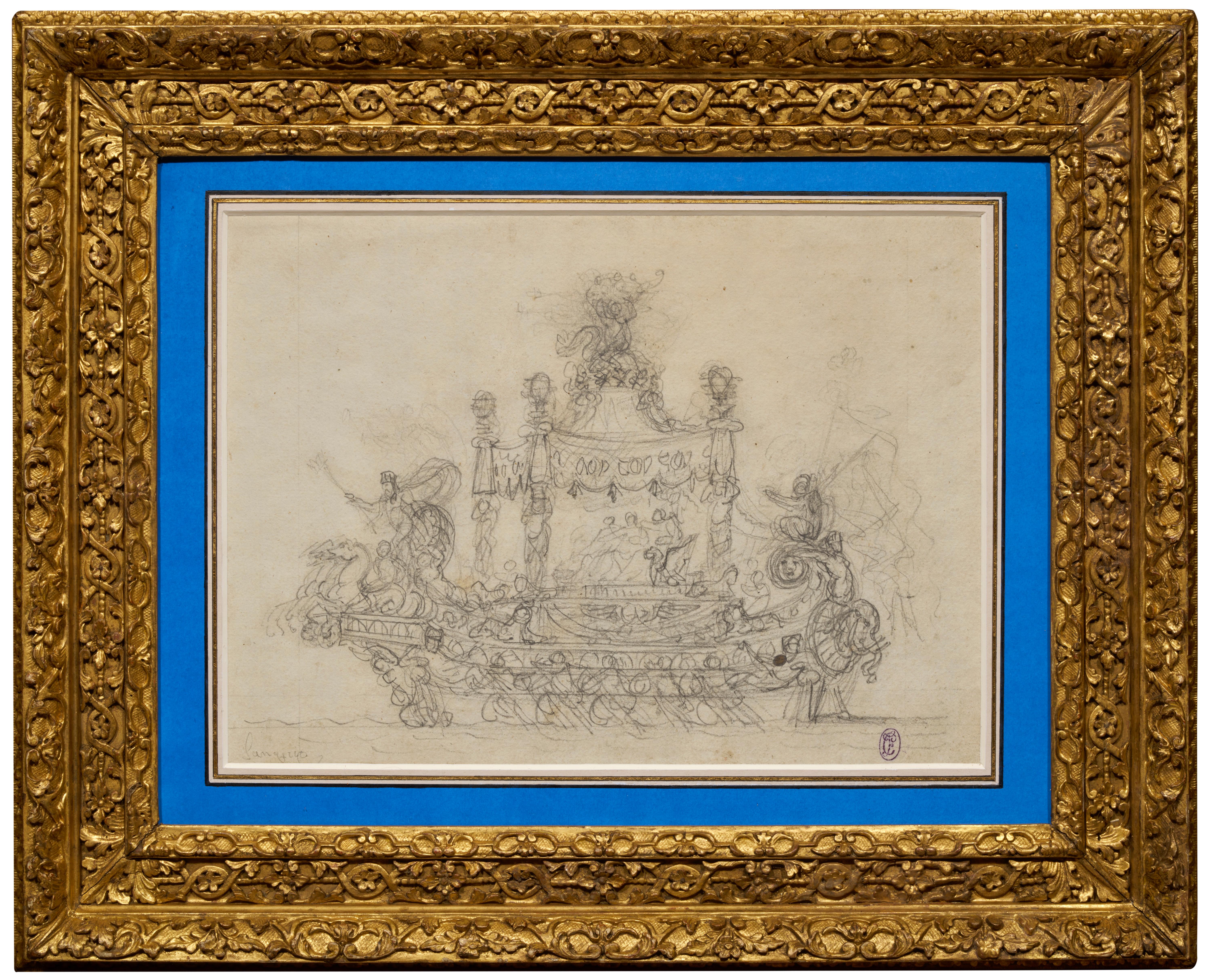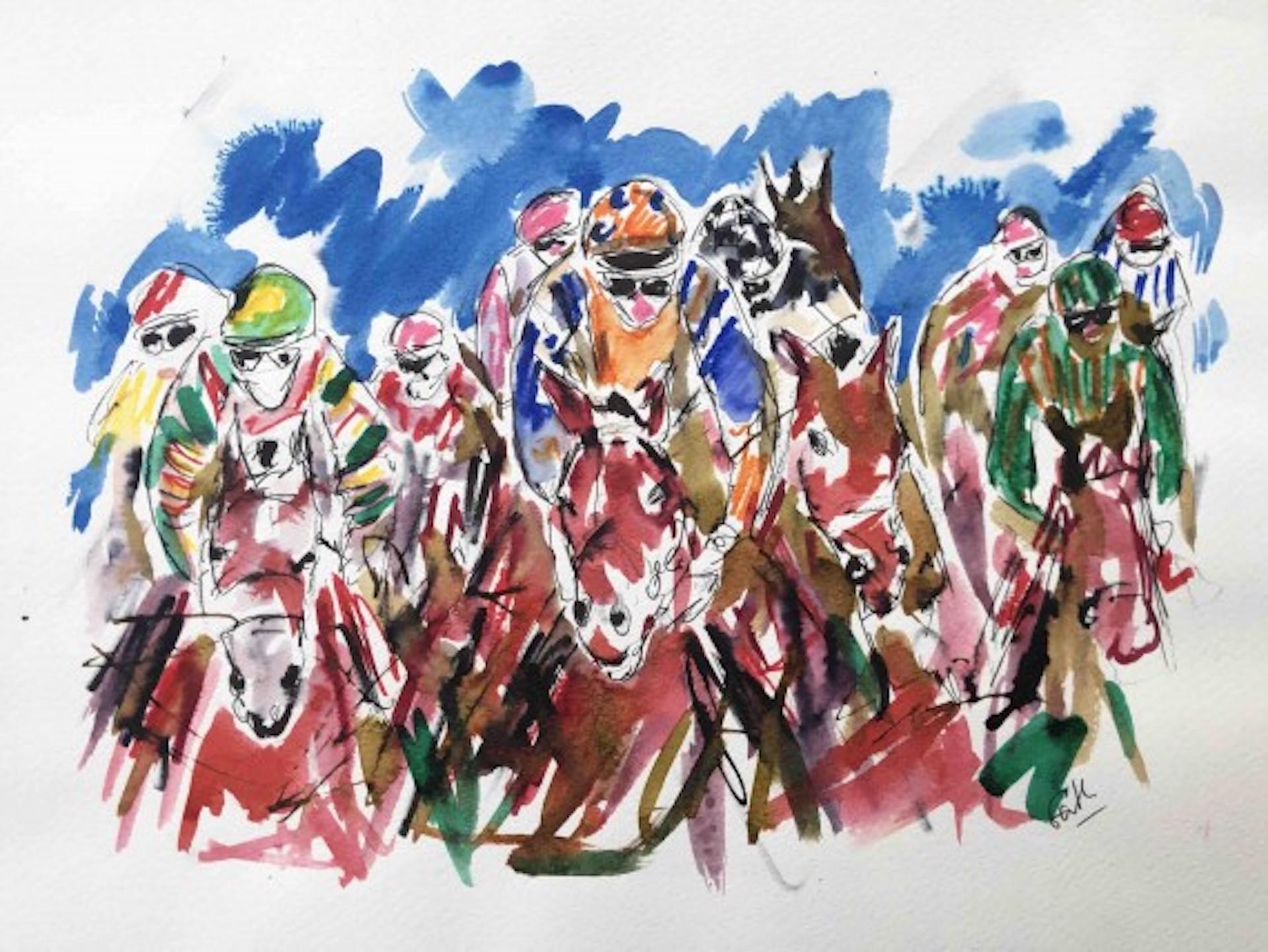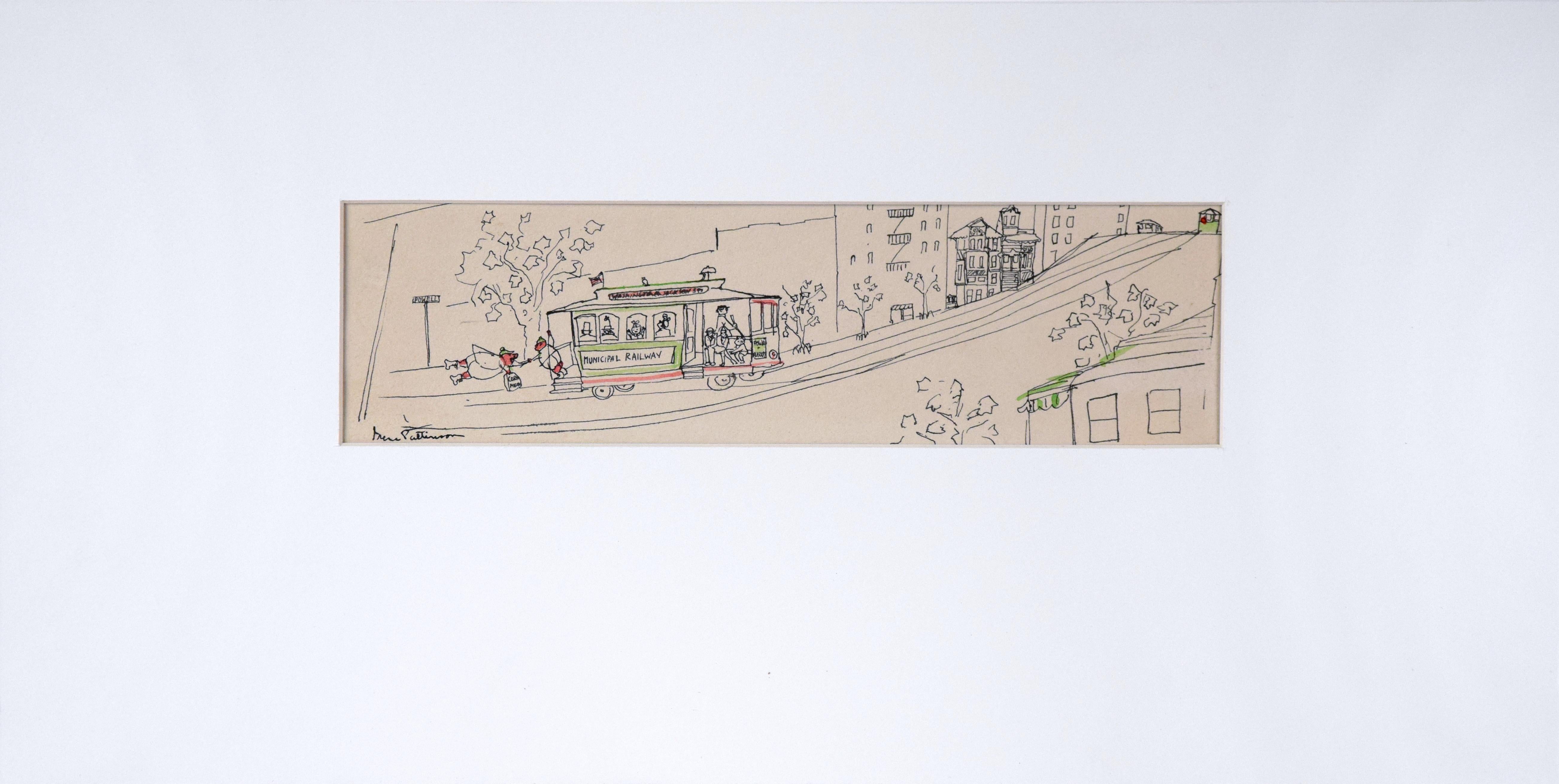Items Similar to The Flight into Egypt
Want more images or videos?
Request additional images or videos from the seller
1 of 5
Luca CambiasoThe Flight into Egypt
About the Item
Inscribed: 3. una Madonna che va in Egitto, verso, and Madonna che va in Egitto, recto
Provenance:
Private Collection, UK, since 1999
This expressive and boldly executed drawing is the work of Luca Cambiaso, the leading artistic personality in Genoa in the sixteenth century and one of the most dynamic draughtsmen in European art. The drawing dates from the mid-1550s to early 1560s at the height of the artist’s power. At this moment in his career, defined by his “serene style,” Cambiaso’s compositions became more focused and reduced to their essential elements. The mule’s hind quarters dominate the visual field and the outdoor setting is indicated by little more than the tree standing along the left edge of the sheet. The large scale of the drawing and the calligraphic penmanship, which lends a motion and drama to the scene, provide significant visual interest and appeal to the modern eye. Cambiaso’s spontaneous handling fully exploits the dynamics of the quill pen—the lines are vigorous, animated, and possess a great suggestive power. Both vibrant and audacious in its depiction of the Flight into Egypt, this drawing represents an exceptional addition to Cambiaso’s graphic oeuvre.
Cambiaso infuses the otherwise inert biblical narrative with dynamism by placing the figures close to the pictorial plane and orienting them along a steep diagonal, from the upper left to the lower right, giving the appearance that they are about to descend a steep slope and disappear from view. The artist employed a similar vertiginous compositional device in his drawing of the Chariot of the Setting Sun, in which the horses are similarly conceived. More explicitly, and using the same media, Cambiaso’s drawing of Saint Martin and Beggar in the Princeton Art Museum displays a horse almost identically envisaged (Fig. 1). A horse seen from behind with its right rear leg raised was a leitmotif for the artist, with some details, such as the diagonal hatching to indicate the shadow on the underside of the hoof, closely repeated. Regarding the representation of the mule in the present drawing, it is important to note Cambiaso’s acute sensitivity to the subject matter, even when composing with speed. In contrast to his many drawings that include horses with elaborate tack, such as the Saint Martin and the Beggar, our composition shows a plain stirrup and strap across the mule’s hindquarters and its tail is not elaborately plaited. The treatment is in keeping with the theme of poverty that underlies this biblical subject (Matthew 2:13-15). The Holy Family were, after all, refugees, and the fact that Herod was intent on killing the child would appear to explain Joseph’s somewhat anxious glance over his shoulder.
The drawing displays many of the salient characteristics of Cambiaso’s draughtsmanship. In a manner entirely consistent with his working method, he first sketched his preliminary ideas with thin pen lines in a lighter ink over faint traces of black chalk and later confirmed or corrected them with a darker tone of brown. As is typical of the artist, spare hatching suggests the surrounding space and foreground terrain. Half-moon like circlets indicate pebbles in the foreground, with long looping lines defining the leaves of the palm tree, terminating in hooks as the pen shifts from right to left. Typically, limbs, hands, lips, noses and eyelids are slightly geometricized with circlets, triangles, ticks and hooks, and quick flicks of the pen indicate knees, muscles and tendons. The articulation of the Virgin’s hand and the physiognomy of the infant Christ are nearly identical to those in Cambiaso’s Virgin and Child with Putti, formerly in the collection of the Rugby School (Fig. 2). Tellingly, so too is the relationship between mother and child, as the Virgin intimately embraces the infant Christ.
Within the context of Cambiaso’s drawings, the scale and format of this work, the quality of execution, and above all its striking interpretation of the subject suggest that it was conceived as an autonomous work rather than a preparatory study for a painting. Its monumentality, dynamism, and the clarity of narrative appear to connect it with a number of comparably large drawings illustrating the early life of Christ. These include two versions of the Holy Family at Rest preserved in the Rijksmuseum and the First Steps of the Infant Christ in Edinburgh. The early inscription on the verso of this sheet—“3. una Madonna che va in Egitto”—suggests it may have been the third in sequence of a series of subjects drawn on a similar scale in the same technique owned by an early collector. Cambiaso’s only known treatment of the subject in paint is an altarpiece of La Fuga in Egitto that is mentioned in an early guidebook to Genoa as in the church of Santa Maria delle Grazie al Molo outside the city, close to the Porta Lanterna (current location unknown).
- Creator:Luca Cambiaso (1527 - 1585, Italian)
- Dimensions:Height: 14.875 in (37.79 cm)Width: 11.25 in (28.58 cm)
- Medium:
- Movement & Style:
- Period:
- Condition:
- Gallery Location:New York, NY
- Reference Number:1stDibs: LU1029077782

About the Seller
5.0
Recognized Seller
These prestigious sellers are industry leaders and represent the highest echelon for item quality and design.
Established in 1997
1stDibs seller since 2012
17 sales on 1stDibs
- ShippingRetrieving quote...Ships From: New York, NY
- Return PolicyThis item cannot be returned.
More From This SellerView All
- Orpheus and the Animals, A Study after an Ancient Bas-ReliefLocated in New York, NYInscribed “55” and “218” in the lower right Watermark: Heawood 1351 Laid down on historic Cassiano Del Pozzo mount (Mount Type A, 531 x 402 mm) Provenance: Commissioned by Cassiano dal Pozzo (1588–1637) for his Museo Cartaceo (Paper Museum) and kept in the library of his palazzo, via dei Chiavari, Rome Transferred with the entire dal Pozzo collection by fidecommesso to his younger brother, Carlo Antonio dal Pozzo (1606–1689); by descent to his second son: Gabriele dal Pozzo (d. 1695); by descent to his wife: Anna Teresa Benzoni and after her remarriage in 1697, the Marchesa Lancellotti de’ Ginnetti (d. 1736); by descent to their son: Cosimo Antonio dal Pozzo (d. 1740); by whom sold with the Dal Pozzo library in 1703 to: Pope Clement XI for the Vatican Library; by whom transferred as part of the Museo Cartaceo in January 1714 to his nephew: Cardinal Alessandro Albani (1692–1779), Palazzo ‘alle Quattro Fontane’ in Rome; by whom sold in 1762 to: James Adam, agent for the British Royal Librarian Richard Dalton (1715–1791) King George III of England, Buckingham House Among the sheets of the ‘Museo Cartaceo’ appropriated by Richard Dalton during a reorganization of the drawings, circa 1786-1788; his estate sale, Greenwood’s, London, 11-19 May 1791; where acquired by: John MacGowan...Category
16th Century Baroque Figurative Drawings and Watercolors
MaterialsPaper, Ink, Pen
- The Martyrdom of the Santi Quattro CoronatiLocated in New York, NYProvenance: Private Collection, UK After initial training under Justus Suttermans and Vincenzo Dandini, in 1673 Anton Domenico Gabbiani embar...Category
17th Century Old Masters Figurative Drawings and Watercolors
MaterialsChalk, Paper, Ink, Pen
- A Mother and Child, Two Children, and a DogBy Stefano Della BellaLocated in New York, NYProvenance: Elsie de Woolfe, Lady Mendl, Paris; by whom given in 1950 to: Arlene Dahl, New York (until 2021) Inventive, whimsical, and fantastic; delightful, imaginative, and maca...Category
17th Century Old Masters Interior Drawings and Watercolors
MaterialsPaper, Pen, Ink
- The Assumption of the VirginLocated in New York, NYProvenance: Unidentified collector’s mark “D.G.R,” lower right (Lugt 757b) Wilhelm Suida (1877–1959), New York; by descent to: Robert L. and Bertina Suida Manning, New York, until 1996 Private Collection, USA This impressive drawing of the Assumption of the Virgin is the work of the Genoese artist Giovanni Battista Paggi. The son of a nobleman, Paggi received a humanist education and was a self-taught artist. According to Paggi’s first biographer, Raffaele Soprani, it was only after encountering Luca...Category
16th Century Old Masters Figurative Drawings and Watercolors
MaterialsInk, Paper, Pen
- Study of a Bull and Study of Two Heads with Laurel Crowns (recto and verso)Located in New York, NYProvenance: (Possibly) Wilhelm Suida; thence by descent to: Robert L. and Bertina Suida Manning, New York, until 1996 Private Collection, USA Traditionally attributed to the French...Category
17th Century French School Drawings and Watercolor Paintings
MaterialsPaper, Chalk
- Study after Michelangelo’s “The Last Judgment”By Michelangelo BuonarrotiLocated in New York, NYItalian School, 16th Century Provenance: Private Collection, New York This intriguing drawing is a study by an anonymous 16th-century Italian artist after a vignette in Michelangelo’s fresco of The Last Judgement in the Sistine Chapel. The altar wall of the Sistine Chapel was already richly decorated when Pope Clement VII commissioned Michelangelo to paint his Last Judgment...Category
16th Century Old Masters Figurative Drawings and Watercolors
MaterialsGouache, Paper
You May Also Like
- Umbilical Filigree Ovum (drawing)By Hunter StablerLocated in Philadelphia, PAThis is an original India ink, graphite, chalk, and pen on paper drawing by Hunter Stabler measuring 14.25”h x 20.25”w framed. The piece ships in the pictured frame. Hunter Stable...Category
21st Century and Contemporary Contemporary Figurative Drawings and Water...
MaterialsPaper, Graphite, Ballpoint Pen, India Ink, Chalk
- A dazzling Venetian Regatta Boat Study attributed to Alessandra MauroLocated in PARIS, FRThis stunning Baroque study depicts a regatta boat, a type of vessel developed in eighteenth-century Venice for the regattas organized by the Serenissima during visits by royalty and princes. We propose to link this drawing to the work of Alessandro Mauro, an artist who specialized in this type of composition, as illustrated by a drawing from him at the Metropolitan Museum. 1. Description of the boat The greatest decorative fantasy reigns in this preparatory study, which blends mythological and exotic elements with references to ancient Egypt. Our drawing is probably an initial thought, destined to be refined and clarified later in pen and ink (as evidenced by the ink stain in the lower right). A quadriga of seahorses guided by Neptune stands at the stern of the boat, shown well above the waterline (perhaps to outline its empty volume). One of the seahorses is ridden by a newt, while Amphitrite lies at the feet of the sea god. The center of the boat is occupied by a vast baldachin resting on four atlantes and surmounted by a figure riding an animal (a dragon?). Three figures sit beneath the canopy, one of them on a griffin-shaped seat. This allusion to Egyptian antiquity echoes the winged sun (sometimes a symbol of the god Horus, as in the temple of Edfu in Egypt) that adorns the sides of the promontory on which this baldachin rests. Another flag-bearer figure crouches at the stern of the boat on a raised seat, on the reverse of which is a crowned mermaid whose arm, extended backwards, rests on a mascaron decorated with a radiant face (Helios?) and whose torso surmounts an elephant's head. The heads of the rowers and their oars are sketched all along the boat, whose sides are embellished with elongated naiads. 2. The Venetian regatta boats An exhibition held in 2013 at the Ca' Rezzonico (the Venetian eighteenth-century museum) paid tribute to these regatta boats through studies and prints depicting them. The regattas organized by the Serenissima in honor of visiting princes and sovereigns were among the most spectacular ceremonies in Venice. Some important artists of the 18th century contributed to the creation of these extravagant boats which were given exotic names such as bissona, malgarota or peota. The specialists in this field were Andrea Urbani and the brothers Alessandro and Romualdo Mauro. They were born into a family of theater decorators in Piedmont, but little is known about their detailed biography. Alessandro was the architect of the Dresden opera house and of the St. Samuel Theater in Venice (in collaboration with his brother Romualdo), but also worked as stagehand and set designer in Vienna, Rome and Turin. A drawing produced around 1737 from the Metropolitan Museum (7th photo in the gallery) bears witness to his activity as a regatta boat designer. This drawing is a much more elaborate version than the one presented here, having been entirely reworked in brown ink. However, a figure at the bow of the boat, executed solely in black chalk, still bears witness to a technique similar to that of our drawing. It is difficult to know whether the boat depicted in our drawing was a project for an actual boat or whether it remained in the planning stage, but the front of our boat (Neptune and the quadriga of seahorses ridden by a newt) bears several similarities to that of a parade boat depicted in the print published by Michele Marieschi entitled Regatta on the Grand Canal, between the Foscari and Balbi Palaces (last photo in the gallery). This print is dated 1741, which could confirm that our work dates from around 1740. The area between Neptune and the quadriga that precedes him on this strange paddle-boat appears to be partially submerged, confirming that the waterline of our boat was probably intended to be much lower than the one shown in our drawing. The Correr Museum’s collection holds one of the most important collection of engravings and drawings devoted to these specifically Venetian Baroque productions. These boats were intended to last the duration of a festival. Today, they are only documented by preparatory drawings or prints that testify to the sumptuousness of their decoration. This taste for regatta boats lasted throughout the Venetian eighteenth century, and the conception of regatta boats also attracted great masters such as Giambattista Tiepolo, Francesco Guardi or Giambattista Piranesi...Category
Mid-18th Century Old Masters Figurative Drawings and Watercolors
MaterialsChalk
- Garth Bayley, Heart of the Race, Horse Racing Art, Contemporary Art, Art OnlineBy Garth BayleyLocated in Deddington, GBGarth Bayley Heart of the Race Original Figurative Pen and ink on watercolour paper Image size: H:24 cm x W:32 cm Complete Size of Unframed Work: H:24 cm x W:32 cm x D:0.1cm Sold Unframed Please note that insitu images are purely an indication of how a piece may look Garth Bayley Heart of the Race Original pen and ink painting on watercolour paper Pen and ink on paper Image size: H24 cm x W32 cm x D 0.1cm Sold Unframed Please note that in situ images are purely an indication of how a piece may look. Heart of the Race is an original painting by Garth Bayley. Pen and ink horse racing painting. When you stuck in the middle you have to jostle for space. Horse racing art...Category
21st Century and Contemporary Contemporary Animal Drawings and Watercolors
MaterialsPaper, Ink, Pen
- Garth Bayley, Thunder, Contemporary Art, Horse Racing Art, Affordable ArtBy Garth BayleyLocated in Deddington, GBGarth Bayley Thunder Original Art Pen and ink on paper Image size: H:24 cm x W:32 cm Complete Size of Unframed Work: H:24 cm x W:32 cm x D:0.1cm Sold Unf...Category
21st Century and Contemporary Contemporary Animal Drawings and Watercolors
MaterialsPaper, Ink, Pen
- Pigs on a Trolley - Vintage Picture Book Two-Page Spread IllustrationBy Irene PattinsonLocated in Soquel, CAPigs on a Trolley - Vintage Picture Book Two-Page Spread Illustration A two-page spread in India ink pen and watercolor by Irene Pattinson (Ameri...Category
1950s American Modern Figurative Drawings and Watercolors
MaterialsPaper, India Ink, Watercolor, Pen
- Pigs on a San Francisco Trolley at Powell Street - Vintage IllustrationBy Irene PattinsonLocated in Soquel, CAPigs on a San Francisco Trolley - Vintage Illustration A two-page spread in India ink pen and watercolor by Irene Pattinson (American, 1909-199...Category
1950s American Modern Figurative Drawings and Watercolors
MaterialsPaper, India Ink, Watercolor, Pen
Recently Viewed
View AllMore Ways To Browse
Flight Egypt
Rugby Art
Antique Hand Planer
Mother And Infant
Church Virgins
Hand Palm Tree Painting
Antique Stirrups
Flight To Egypt
Old Master Drawing 16th
Horse Stirrups
Palm Tree Watercolor
Mid Century Modern Palm Leaves
Quill Work
Midcentury Pebble Art
Stirrups Used
Antique Sun And Moon
Antique Mule
Putti Drawing





